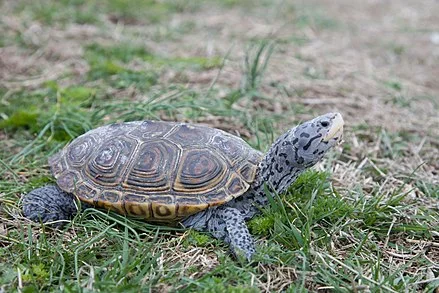
Todd McLeish: Rare Northeast turtles under threat
Diamondback terrapin
From ecoRI News (ecori.org)
Diamondback terrapins are among the rarest turtles in the Northeast, and the only ones that spend most of their lives in salt marshes and other quiet brackish waters. While populations are holding their own in many locations, nest predators are an increasingly serious threat.
Three researchers speaking at last month’s Northeast Natural History Conference in Springfield, Mass., said that in almost every year the eggs in most of the terrapin nests they monitor are consumed by predators.
“Raccoons are the most important predator,” said Russell Burke, a Hofstra University biology professor who has studied diamondback terrapins at the Jamaica Bay National Wildlife Refuge in New York City for 20 years. “Everyone who works on terrapins has had the experience of watching a terrapin put a nest in the ground, and you come back the next day and find a collapsed nest hole and broken eggs.”
Danielle Marston, a volunteer terrapin monitor with the New England Coastal Wildlife Alliance, said raccoons destroy most of the nests she has observed in Buzzard’s Bay, Mass. George Bancroft, who monitors terrapins in the lower Taunton River watershed, also indicated that nest predation rates are very high.
Burke worried that the tiny survey flags he placed to mark the locations of the nests he monitored could be a roadmap for raccoons to follow to terrapin nests, so he conducted a study to learn what method the raccoons use to find the nests. He placed survey flags of various colors where there were no nests, applied a human scent to other sites, dug artificial nests, and experimented with numerous other factors.
The raccoons ignored most of the sites.
“They seemed to be cued more into a disturbance of the sand than the flags,” he said. “Wherever we dug a hole, the raccoons were interested. If you dig any kind of hole in the nesting area, the raccoons were likely to dig it up.”
Burke believes that microbes in the sand become active and release a detectable odor when the sand becomes aerated by digging a hole. But the smell dissipates within about a day or two.
“We get essentially no predation after the second day after nesting,” he said. “If the nests make it through 48 hours, they make it all the way to hatching, and that’s probably due to olfaction.”
Burke noted that there is often increased nesting activity and decreased nest predation when it rains, perhaps because the rain hides the microbe odor.
“It seems to be one of the strategies that terrapins have evolved to minimize raccoon predation,” he said.
Those who monitor diamondback terrapin nests in Rhode Island have also found high rates of nest predation, but some are succeeding in combatting it.
At Hundred Acre Cove in Barrington, where Charlotte Sornborger has been monitoring the terrapins for nearly 30 years, between 200 and 300 nests were destroyed by predators each year during the first 15 years of her studies. In addition to raccoons, Sornborger confirmed that foxes, skunks, and coyotes also predated the nests. But when she began using wire mesh “excluders,” which prohibit scavengers from digging below the surface to reach the eggs, predation rates declined significantly.
Predation at a recently discovered terrapin nesting site at the mouth of the Hunt River in Warwick was very high during the first year of monitoring in 2015 — just three of 87 nests survived to hatch — with dogs being among the chief culprits. But recent surveys have indicated that predation may not be as high as originally thought, according to University of Rhode Island professor Laura Meyerson.
Two surprising new predators, however, have been added to the list of threats to diamondback terrapins: bald eagles and osprey. Neither disturbs the terrapin nests, but the birds have been found to prey on juvenile terrapins in Buzzard’s Bay and in the Palmer River near the Barrington population. According to Sornborger, a hunter reported empty terrapin shells under an osprey platform used by bald eagles along the Palmer River, and two nearby homeowners also observed empty terrapin shells on their lawns.
Another new threat to diamondback terrapin populations is also emerging: rising sea levels.
“For Rhode Island’s terrapins, sea-level rise is really worrisome,” said Scott Buchanan, a herpetologist for the Rhode Island Department of Environmental Management. “They live right at the margins of the coastal zone, and their habitat type is going to experience dramatic alterations and impacts from sea-level rise. We don’t know what that’s going to mean for terrapins.”
“The biggest issue for us in Buzzard’s Bay,” Marston said, “is that we’re losing ground to the big surge in tidal action at our nesting locations. The nesting area is going to disappear with the projected sea-level rise. Already we’re seeing that the nests that don’t fail from predation fail from an intrusion of water into the nests. The terrapins keep trying to nest where they used to, and the nests keep getting flooded.”
With little nesting habitat available inland of their present nesting sites, the combination of predators and rising seas makes the long-term outlook for the species uncertain.
Rhode Island resident and author Todd McLeish runs a wildlife blog.
